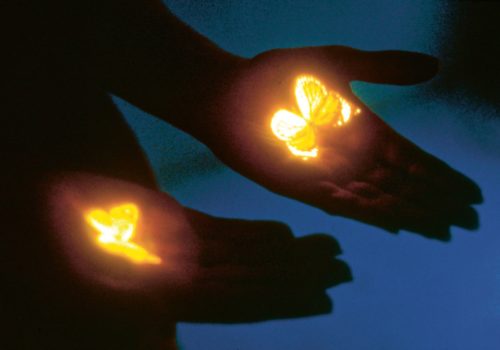Kodak’s decision to resume the production of Ektachrome film, and perhaps eventually Kodachrome, may breathe new life into the good old slide. It might also revive the ritual of the slide tray, the projector, the rollup screen, the lightbox or the linen tester, which have been made seemingly obsolete by the digital image.
The Musée de l’Elysée in Lausanne has had the brilliant idea of revisiting the history of slides. The Swiss institution has expanded the scope of its exhibition to include projected photography, from its development in the second half of the nineteenth century until its popularization in the 1960s and 70s. The museum is plunged into darkness that is favorable to slide shows, bringing back the now-forgotten sound of projectors, the heat emanating from their lamps, the dust dancing in front of the lens, and above all the inimitable brightness of Kodachrome, Ekta, Fuji, and Agfa films. If photography really is writing with light, here we can see it in action, telling all sorts of stories right before our astonished eyes.
The exhibition examines the status of slides, or transparent images enclosed in cardboard or plastic frames, in the history of photography. The story is built more around the durable slide than around the ephemeral act of projecting it. This is because the use of color reversible film has been associated with a dated, popular amateur practice. This “middle-brow art,” to borrow Bourdieu’s term, brings to mind family gatherings, public conferences, lectures given in auditoriums. Sometimes it evokes boredom provoked by repetitive images, erudite commentary, or the tedious reminiscing of an uncle on his travels .
Divided into four sections—the light images, the apparatus, sequence, and screening–—the exhibition also reminds us about the inventive use of the slide by conceptual artists, starting in the 1960s. Dan Graham, Robert Smithson, Allan Sekula, Nan Goldin, and James Coleman, among others, have taken advantage of the narrative potential of slide shows to examine their times, their intimate relations, and photography itself. The works of professional photographers, such as Alfred Stieglitz and Helen Lewitt, figure in the exhibition alongside Le Corbusier and Charles Eames. The bottom line is: the rise of the slide sparked the invention of new forms of communication, anticipating the current flow of images and data.
It is a pity, however, that the exhibition does not mention the basic use of the slide in mass media, starting with the press. Isn’t late twentieth-century newspaper printed in saturated, Kodachrome colors? The Musée de l’Elysée has also forgotten its own genius loci: Lausanne has long been home to one of the world’s largest Kodachrome labs, renowned for the quality of film processing and one of the last surviving labs, against all (digital) odds.
But let’s be fair, the museum does, after all, respect the spirit of the place: it has recently announced that the Sabine Weiss archives will be entered into its collections. Residing in Paris since 1946, the great humanist photographer was born in 1924 in French-speaking Switzerland, in Saint-Gingolph. The collection comprises 200,000 negatives, 7,000 contact sheets, 8,000 vintage and recent prints, over a dozen complete exhibitions, a wealth of documents, and … let’s not forget, 2,000 slides!
Luc Debraine
Luc Debraine is a cultural and society journalist at the Swiss magazine Hebdo.
Slides: The History of Projected Photography
June 1 to September 24, 2017
Musée de l’Elysée
18, avenue de l’Elysée
1014 Lausanne
Suisse
















